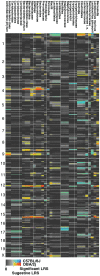Murine gut microbiota is defined by host genetics and modulates variation of metabolic traits
- PMID: 22723961
- PMCID: PMC3377628
- DOI: 10.1371/journal.pone.0039191
Murine gut microbiota is defined by host genetics and modulates variation of metabolic traits
Abstract
The gastrointestinal tract harbors a complex and diverse microbiota that has an important role in host metabolism. Microbial diversity is influenced by a combination of environmental and host genetic factors and is associated with several polygenic diseases. In this study we combined next-generation sequencing, genetic mapping, and a set of physiological traits of the BXD mouse population to explore genetic factors that explain differences in gut microbiota and its impact on metabolic traits. Molecular profiling of the gut microbiota revealed important quantitative differences in microbial composition among BXD strains. These differences in gut microbial composition are influenced by host-genetics, which is complex and involves many loci. Linkage analysis defined Quantitative Trait Loci (QTLs) restricted to a particular taxon, branch or that influenced the variation of taxa across phyla. Gene expression within the gastrointestinal tract and sequence analysis of the parental genomes in the QTL regions uncovered candidate genes with potential to alter gut immunological profiles and impact the balance between gut microbial communities. A QTL region on Chr 4 that overlaps several interferon genes modulates the population of Bacteroides, and potentially Bacteroidetes and Firmicutes-the predominant BXD gut phyla. Irak4, a signaling molecule in the Toll-like receptor pathways is a candidate for the QTL on Chr15 that modulates Rikenellaceae, whereas Tgfb3, a cytokine modulating the barrier function of the intestine and tolerance to commensal bacteria, overlaps a QTL on Chr 12 that influence Prevotellaceae. Relationships between gut microflora, morphological and metabolic traits were uncovered, some potentially a result of common genetic sources of variation.
Conflict of interest statement
Figures


References
-
- Barbosa T, Rescigno M. Host-bacteria interactions in the intestine: homeostasis to chronic inflammation. Wiley Interdiscip Rev Syst Biol Med. 2010. pp. 80–97. - PubMed
-
- Cerf-Bensussan N, Gaboriau-Routhiau V. The immune system and the gut microbiota: friends or foes? Nat Rev Immunol. 2010;10:735–744. - PubMed
-
- Scarpellini E, Campanale M, Leone D, Purchiaroni F, Vitale G, et al. Gut microbiota and obesity. Intern Emerg Med. 2010;5:S53–56. - PubMed
Publication types
MeSH terms
Grants and funding
LinkOut - more resources
Full Text Sources
Molecular Biology Databases

